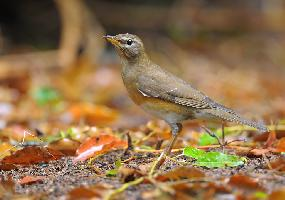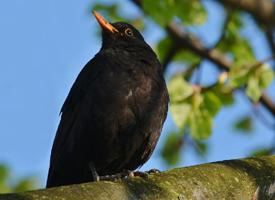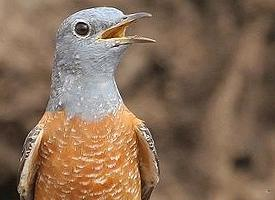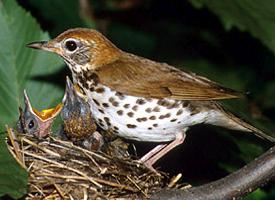
Description de l'animal
The Eyebrowed Thrush (Turdus obscurus) is a captivating bird species belonging to the thrush family, Turdidae, renowned for its melodious song and distinctive plumage. This medium-sized bird possesses a striking appearance, characterized by its subtle yet elegant coloration and distinctive markings, which have endeared it to birdwatchers and nature enthusiasts alike.Measuring approximately 20 to 24 centimeters in length, the Eyebrowed Thrush has a robust and graceful silhouette. The bird's plumage is primarily a rich, dusky brown on the upper parts, seamlessly transitioning into a warmer, olive-brown hue towards the tail. The underparts display a softer, off-white to pale grey, adorned with dark, round spots that provide a beautiful contrast and add to the bird's exquisite appearance.
One of the most distinctive features of the Eyebrowed Thrush is, as its name suggests, the prominent creamy-white supercilium or "eyebrow" that extends from the base of its beak, over the eye, and towards the back of its head. This striking feature is set against a darker facial area, creating a captivating contrast that is both elegant and bold. The bird's eyes are a deep, expressive brown, while its beak is a subtle yellow with a darker tip, perfectly complemented by its greyish-pink legs and feet.
The Eyebrowed Thrush is a migratory bird, breeding in the dense forests of Siberia, Northeast China, and North Korea, and spending the winter months in the tropical regions of Southeast Asia, including the Philippines, Indonesia, and Thailand. Its preferred habitats are dense woodlands and forest edges, where it can be found foraging on the ground or in the lower canopy, primarily feeding on a diet of insects, worms, and various fruits and berries.
The song of the Eyebrowed Thrush is a delightful symphony of melodious whistles, often infused with a series of trills and chirps. During the breeding season, males can be heard singing from high perches to attract mates and establish territories, filling the air with their enchanting melodies.
Breeding usually takes place in the early summer months. The Eyebrowed Thrush is a solitary nester, with females meticulously constructing cup-shaped nests in the forks of trees, using twigs, grasses, and leaves. The nests are often lined with softer materials to provide comfort and warmth for the eggs. A typical clutch consists of 3 to 5 pale blue eggs, which are incubated by the female for about two weeks before hatching.
Despite facing threats from habitat loss and degradation, particularly in its breeding grounds, the Eyebrowed Thrush is currently listed as Least Concern by the International Union for Conservation of Nature (IUCN), thanks to its wide distribution and relatively stable population. Nonetheless, continued conservation efforts are essential to ensure the survival of this species and the preservation of its natural habitats.
In conclusion, the Eyebrowed Thrush is a truly remarkable bird, admired not only for its beauty and song but also for its fascinating migratory journey and adaptability. As a symbol of the rich biodiversity of our planet, it serves as a reminder of the importance of conserving natural habitats for the myriad species that depend on them.
Animaux similaires
Nouvelles photos d'animaux
Top 10 des animaux
- Dolphin gull (Leucophaeus scoresbii)
- Diana monkey (Cercopithecus diana)
- Moustached guenon (Cercopithecus cephus)
- Galápagos tortoise (Geochelone nigra complex)
- Japanese macaque (Macaca fuscata)
- Stone loach (Barbatula barbatula)
- Russian tortoise (Testudo horsfieldii)
- Greek tortoise (Testudo graeca)
- Common flying dragon (Draco volans)
- Vendace (Coregonus albula)


